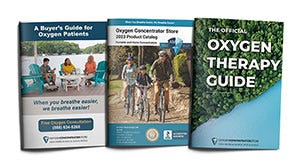Are portable oxygen concentrators allowed on airplanes?
Yes. Portable oxygen concentrators (POCs) are allowed on airplanes. In fact, they’re the only form of oxygen that passengers can use during a flight. However, taking a POC on an airplane requires some preparation.
Take these steps ahead of time to ensure your safety and avoid running into issues:

Talking With Your Physician:
Talking with your physician before your travel is a crucial step in planning your trip. Some passengers experience low blood oxygen levels at high elevations. Your physician can determine whether it’s safe for you to fly.
Some passengers may travel with a pulse oximeter (to check blood oxygen levels) or take an altitude simulation test ordered by their doctors to ensure their safety before flying. However, many passengers only require a prescription and a physician’s statement from their doctor.
While speaking with your provider, ensure you understand your prescription for your POC, especially if you generally use a stationary concentrator or another form of oxygen. POC settings provide different oxygen outputs for each unit. For example, a setting of 2 on one machine delivers a different amount of oxygen with each breath than another POC. Clarify your needs with your doctor to ensure you receive the right amount of oxygen during your trip.
For more information view our blog post on the Guide to Flying with an Oxygen Concentrator or view FAA Approved Portable Concentrators.
Updated: April 10, 2023
Take these steps ahead of time to ensure your safety and avoid running into issues:
- First, talk to your physician about your travel plans. Clarify your oxygen requirements and get a physician’s statement that states these requirements. Although the FAA does not require a statement, many airlines do.
- Check the airline battery requirements. Bring enough battery power for at least 150% of your flight time. Spare batteries on board must remain in the original packaging or insulated terminals. Check the airline’s policy on battery storage.
- Ensure your POC received FAA approval. The FAA provides a list of approved POCs, but you’ll also want to check the airline’s policy.
- Arrive for your flight early to give yourself extra time to check-in.
- You can rent a POC or spare batteries for your trip if you don’t already own them.
- Airlines do not consider POCs carry-on bags.
- Carry your oxygen prescription and physician’s statement with you on your flight.

Talking With Your Physician:
Talking with your physician before your travel is a crucial step in planning your trip. Some passengers experience low blood oxygen levels at high elevations. Your physician can determine whether it’s safe for you to fly.
Some passengers may travel with a pulse oximeter (to check blood oxygen levels) or take an altitude simulation test ordered by their doctors to ensure their safety before flying. However, many passengers only require a prescription and a physician’s statement from their doctor.
While speaking with your provider, ensure you understand your prescription for your POC, especially if you generally use a stationary concentrator or another form of oxygen. POC settings provide different oxygen outputs for each unit. For example, a setting of 2 on one machine delivers a different amount of oxygen with each breath than another POC. Clarify your needs with your doctor to ensure you receive the right amount of oxygen during your trip.
For more information view our blog post on the Guide to Flying with an Oxygen Concentrator or view FAA Approved Portable Concentrators.
Updated: April 10, 2023

